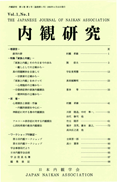Volume 25, Issue 1
Displaying 1-11 of 11 articles from this issue
- |<
- <
- 1
- >
- >|
OPENING REMARKS
-
2019 Volume 25 Issue 1 Pages 1-2
Published: September 01, 2019
Released on J-STAGE: December 26, 2020
Download PDF (872K)
SPECIAL FOCUS Considering effective methods of Naikan Reflections on the present and future of Naikan Therapy
-
2019 Volume 25 Issue 1 Pages 3-4
Published: September 01, 2019
Released on J-STAGE: December 26, 2020
Download PDF (873K) -
2019 Volume 25 Issue 1 Pages 5-9
Published: September 01, 2019
Released on J-STAGE: December 26, 2020
Download PDF (968K) -
2019 Volume 25 Issue 1 Pages 11-13
Published: September 01, 2019
Released on J-STAGE: December 26, 2020
Download PDF (988K) -
2019 Volume 25 Issue 1 Pages 15-17
Published: September 01, 2019
Released on J-STAGE: December 26, 2020
Download PDF (873K) -
2019 Volume 25 Issue 1 Pages 19-22
Published: September 01, 2019
Released on J-STAGE: December 26, 2020
Download PDF (998K) -
2019 Volume 25 Issue 1 Pages 23-27
Published: September 01, 2019
Released on J-STAGE: December 26, 2020
Download PDF (1073K) -
2019 Volume 25 Issue 1 Pages 29-30
Published: September 01, 2019
Released on J-STAGE: December 26, 2020
Download PDF (872K)
POINT OF CONTENTION
-
2019 Volume 25 Issue 1 Pages 31-39
Published: September 01, 2019
Released on J-STAGE: December 26, 2020
Download PDF (1329K) -
2019 Volume 25 Issue 1 Pages 41-45
Published: September 01, 2019
Released on J-STAGE: December 26, 2020
Download PDF (1031K)
SHORT REPORT
-
2019 Volume 25 Issue 1 Pages 47-54
Published: September 01, 2019
Released on J-STAGE: December 26, 2020
Download PDF (1102K)
- |<
- <
- 1
- >
- >|
